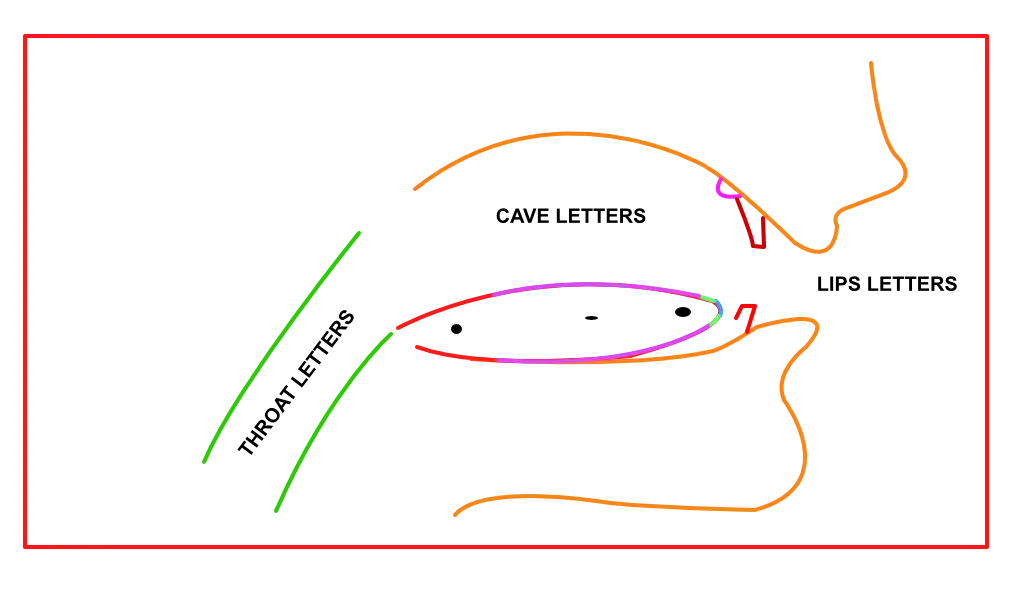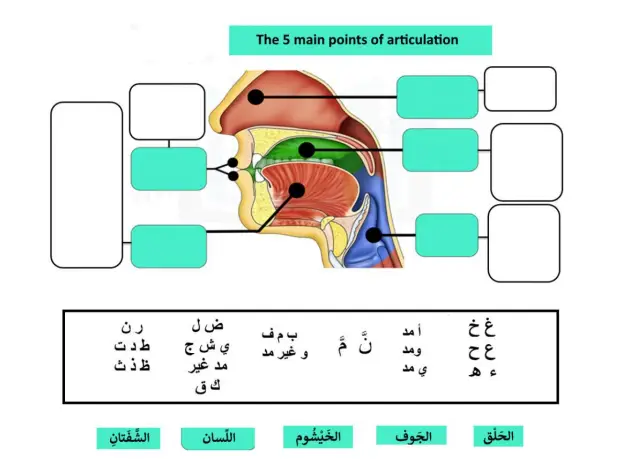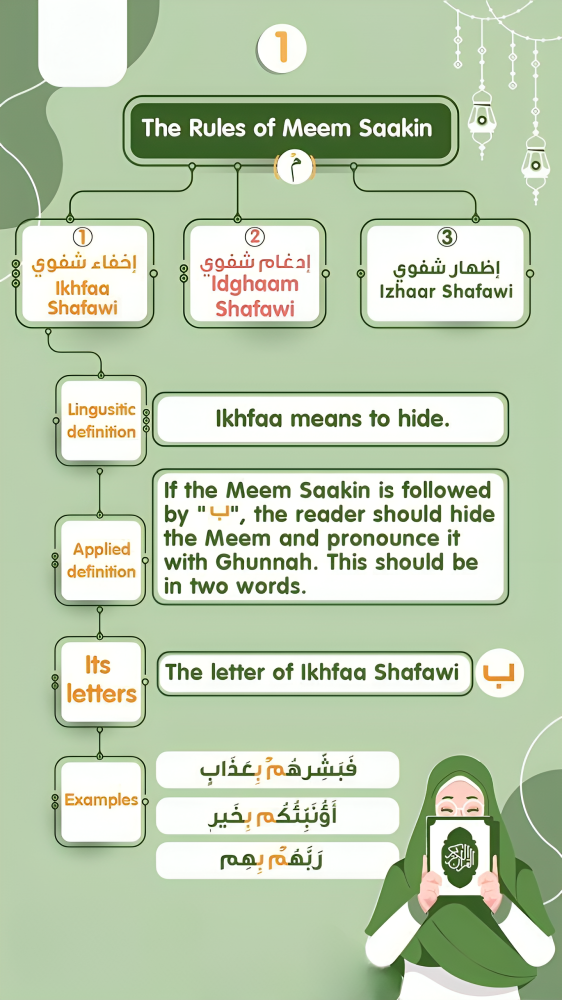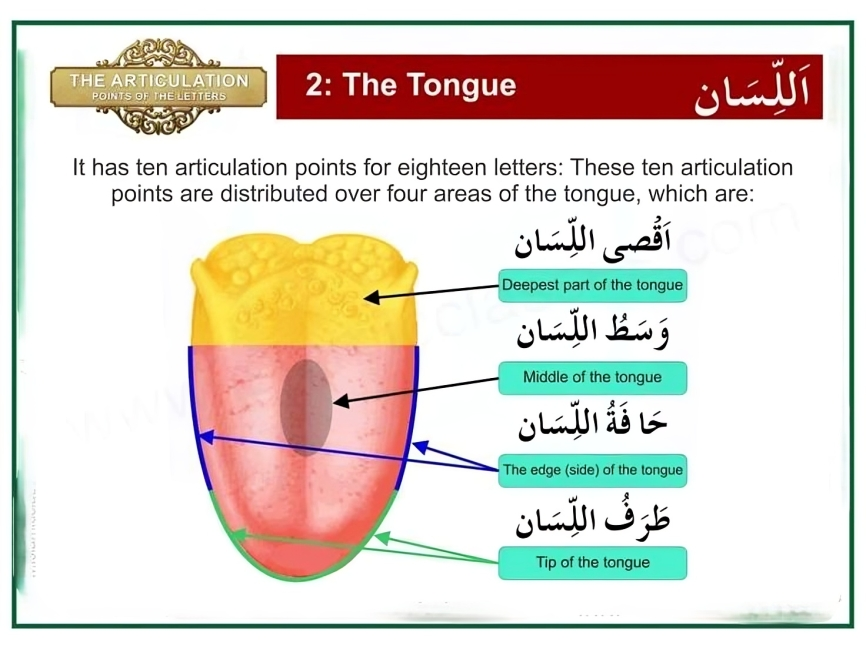Reading the Quran with accuracy and beauty starts with proper pronunciation of Tajweed. At Baytul Quran, one of the first and most important Tajweed concepts we teach is Makharij al-Huroof (مخارج الحروف), the exit points from which the Arabic sounds/letters are articulated. Learning these origins is essential for anyone wishing to recite the Quran correctly, as mixing up two similar letters can change the meaning of Allah’s words.
What Are Makharij al-Huroof?
Every Arabic letter emerges from a precise place in the mouth, throat, tongue, nasal cavity, or lips. These are called Makharij. Knowing these ensures your recitation is not only correct but melodious and pleasing.

Below are the 5 main points of articulation, with examples, based on traditional Tajweed science:
1. Al-Halq (الحلق) Throat Letters
These letters come from various parts of the throat:
- Deepest (أقصى الحلق):
- ء (Hamzah): e.g., in “أمن”
- ه (Ha): e.g., in “هو”
- Middle (وسط الحلق):
- ع (Ain): e.g., in “علم”
- ح (Ha): e.g., in “حمد”
- Closest (أدنى الحلق):
- غ (Ghain): e.g., in “غفر”
- خ (Kha): e.g., in “خرج”
Practice: Say “أحمد” (Ahmad) slowly and feel each throat sound.
2. Al-Jawf (الجوف) Empty Space/Vowel Sounds
These “Madd” or long vowel letters stretch from the empty space in the mouth/throat:
- ا (Alif Maddiyah): as in “قال”
- و (Waw Maddiyah): as in “يقول”
- ي (Ya Maddiyah): as in “قيل”
Practice: Stretch “قال” (“Qaaal”) and notice the echo deep in your mouth.
3. Al-Lisaan (اللسان) Tongue Letters
Most Arabic letters originate from specific regions of the tongue:
- Deep tongue touching the soft palate: ق (Qaaf), e.g., “قلب”
- Base of tongue and palate: ك (Kaaf), e.g., “كتاب”
- Upper tongue and gums: ج (Jeem), ش (Sheen), ي (Ya), e.g., “جيش”
- Tip of tongue and upper front teeth:
- ت (Ta): e.g., “ترك”
- د (Dal): e.g., “دين”
- ط (Toa): e.g., “طريق”
- Edges and tip of tongue: ل (Lam): e.g., “ليل”, ن (Noon): e.g., “نعم”, ر (Raa): e.g., “رب”
- Edge of tongue near molars: ض (Dhad): e.g., “ضرب”
- Between the tip and side teeth (Lisped Sounds):
- ث (Tha): e.g., “ثوب”
- ذ (Dhal): e.g., “ذهب”
- ظ (Zha): e.g., “ظهر”
Practice: Try “ضربت”, feeling the deep edge for “ض” and tip for “ت”.
4. Al-Shafataan (الشفتان) – Lips
Articulated using the inner, outer, or joined lips:
- Joining both lips:
- ب (Ba): “بيت”
- م (Meem): “محمد”
- Lower lip and upper teeth:
- ف (Fa): “فوز”
- Rounding both lips without closing:
- و (Waw): “ورد”
Practice: Try “مبروك”, noticing every unique lip movement.
5. Al-Khayshoom (الخيشوم) Nasal Passage
This point is important for the nasalization (ghunnah) sound in:
- م (Meem) and ن (Noon):
- Practice: Prolong “من”, ensuring the vibration is in your nose.
Why Are Makharij Essential in Quranic Recitation?
- Prevents meaning change: “قلب” (heart) vs “كلب” (dog)
- Fulfills religious obligation: Quranic accuracy is a trust (Amanah)
- Enhances beauty: Correct sounds beautify your voice
Additional Tips
- Watch & learn: Follow our Baytul Quran YouTube channel for Makharij tutorials!
- Join and ask: Participate in Facebook/Instagram live sessions for pronunciation practice and answers from our certified teachers.
- Start practice: Book a free trial on our website for a guided Makharij lesson.
Learning with Baytul Quran means getting personalized feedback every step of the way. Attach the included diagram in your notes for quick reference during classes!
Ready to master the Quran’s articulation? Join Baytul Quran today, connect on our social platforms, and begin your Tajweed journey with confidence!
📢 Learn Tajweed with Baytul Quran
Join our structured online Tajweed courses, designed for both kids and adults, led by certified teachers with Ijazah. Take the next step in your Quranic journey.
🌐 Visit our website
📧 Email: info@baytulquran.com
📱 WhatsApp: +92 300 8737779 | +44 7842 064721
📺 YouTube: Baytul Quran
📸 Instagram: @baytulquran_1





